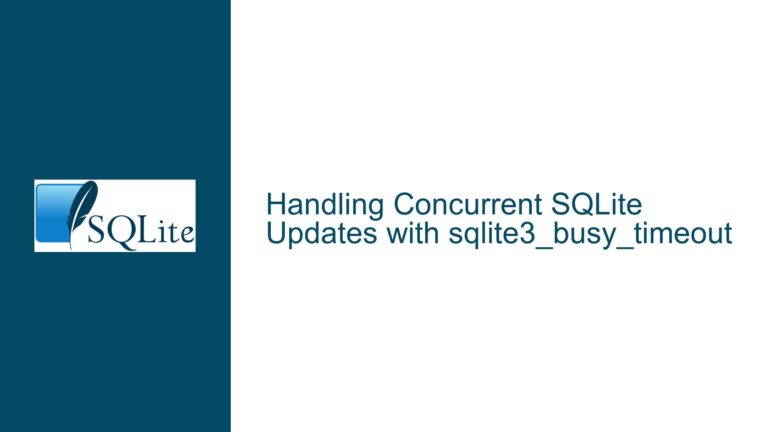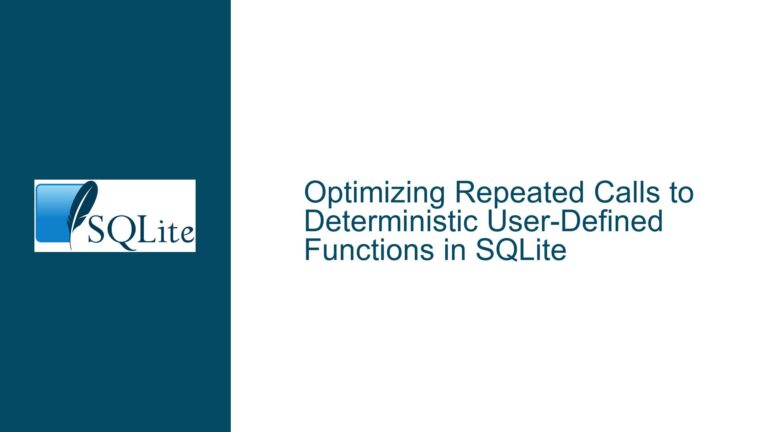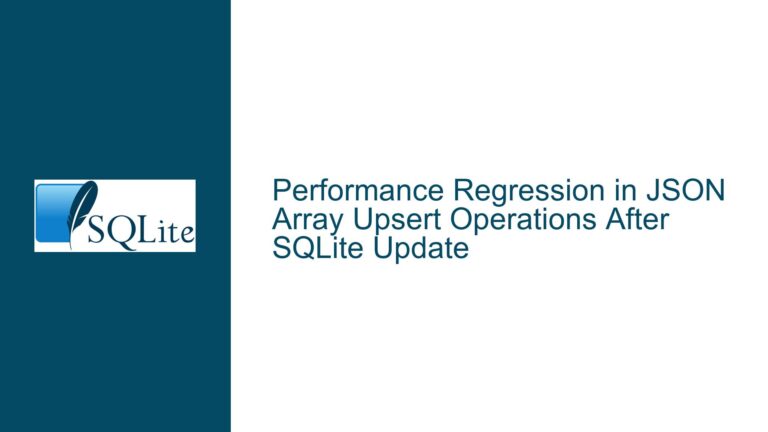Tracking and Optimizing SQLite VACUUM Operations on Large Databases
Understanding the VACUUM Operation and Its Impact on Disk Space
The VACUUM command in SQLite is a critical operation for reclaiming unused space and optimizing database performance. When a table is dropped or a significant amount of data is deleted, SQLite does not immediately release the space back to the filesystem. Instead, the space is marked as free and can be reused by future database operations. The VACUUM command rebuilds the entire database file, effectively removing this free space and reducing the file size. However, this operation can be resource-intensive, especially on large databases, and requires careful consideration of disk space and temporary storage.
In the context of a 612GB database, dropping a large table that occupies approximately half of the database size (around 306GB) necessitates a VACUUM operation to reclaim the space. The user in the discussion correctly identified the need to set a custom temp_store_directory to ensure that the temporary files generated during the VACUUM operation do not exhaust the default /tmp directory space. However, the user also encountered concerns about the disk space on the primary storage device, which initially had only 300GB of free space. This raises questions about the disk space requirements for the VACUUM operation and whether the operation can proceed successfully under these conditions.
The VACUUM operation in SQLite works by creating a new database file and copying the contents of the existing database into this new file. This process ensures that the new database file is compact and free of unused space. However, this also means that the operation requires at least as much free space as the size of the original database file. In this case, the original database file is 612GB, so the operation would require at least 612GB of free space on the destination disk. Additionally, the temporary files generated during the operation can consume significant space, further increasing the total disk space requirement.
The user observed that the temporary file in the custom temp_store_directory fluctuated in size between 200GB and 400GB. This behavior is consistent with the VACUUM operation’s process of reading and writing data in chunks. However, the user’s concern about the operation potentially being stuck due to insufficient initial disk space is valid. If the operation began with insufficient disk space, it could encounter errors when attempting to write to the new database file or the temporary files. These errors could cause the operation to hang or fail silently, leading to an indefinite wait.
Diagnosing Slow VACUUM Operations and Resource Utilization
The second part of the discussion highlights a similar experience where a VACUUM operation ran for several days without completing. The user noted that none of the machine’s resources (CPU, memory, disk I/O) were fully utilized, suggesting that the slowness was not due to hardware limitations. Instead, the user hypothesized that the operation’s performance degraded over time due to UNIQUE constraint checks, which become increasingly expensive as more data is processed.
This hypothesis aligns with SQLite’s internal mechanisms for maintaining data integrity. During the VACUUM operation, SQLite must ensure that all constraints, including UNIQUE constraints, are satisfied in the new database file. As the operation progresses, the number of rows in the new database file increases, and each new row must be checked against all existing rows to enforce UNIQUE constraints. This process can become a bottleneck, especially if the database contains large tables with many UNIQUE constraints.
The user also observed that the temporary file’s growth and shrinkage slowed down over time. This behavior is consistent with the increasing cost of UNIQUE constraint checks. As the operation progresses, the time required to process each chunk of data increases, leading to slower overall progress. This can create the impression that the operation is stuck, even though it is still making progress, albeit at a slower rate.
Monitoring Progress and Optimizing VACUUM Operations
To address the lack of progress indicators during the VACUUM operation, the user in the discussion suggested using the .progress command in the SQLite CLI. This command provides a progress indicator by printing a dot for every specified number of database pages processed. For example, the command sqlite3.exe nameofdatabase.db ".progress 1000000" "pragma temp_store = 2; vacuum into 'vacuumed.db';" prints a dot for every 1,000,000 pages processed. This allows the user to monitor the operation’s progress and estimate the remaining time.
Additionally, the user recommended using the vacuum into syntax to create the new database file on a different drive. This approach has several advantages. First, it reduces the disk space pressure on the primary storage device by offloading the new database file to a secondary drive. Second, it allows the user to monitor the growth of the new database file directly, providing a clear indication of the operation’s progress. Finally, it ensures that the original database file remains intact until the operation completes, reducing the risk of data loss in case of an error.
To further optimize the VACUUM operation, users can consider the following strategies:
Increase Disk Space: Ensure that the destination disk has sufficient free space to accommodate the new database file and temporary files. In this case, the user cleared an additional 500GB of space after the operation started, which likely helped prevent errors due to insufficient disk space.
Use a Faster Storage Device: If possible, perform the VACUUM operation on a faster storage device, such as an SSD. This can significantly reduce the time required for reading and writing data, especially for large databases.
Disable Constraints Temporarily: If the database contains many UNIQUE constraints, consider disabling them temporarily during the VACUUM operation. This can reduce the overhead of constraint checks and speed up the operation. However, this approach should be used with caution, as it can compromise data integrity if not handled properly.
Split the Operation: For extremely large databases, consider splitting the VACUUM operation into smaller chunks. For example, users can vacuum individual tables or indexes separately, reducing the overall resource requirements and making the operation more manageable.
Monitor System Resources: Use system monitoring tools to track CPU, memory, and disk I/O usage during the VACUUM operation. This can help identify potential bottlenecks and optimize resource allocation.
By following these strategies, users can improve the performance and reliability of VACUUM operations on large databases, ensuring that the operation completes successfully and within a reasonable timeframe.





